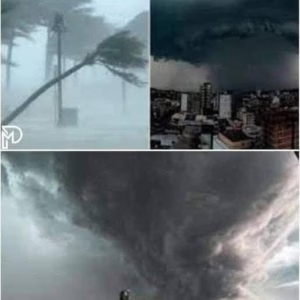In May, a powerful 4.4-magnitude earthquake shook the Phlegraean volcanic fields. It was the strongest quake in 40 years. Over the past six months, more than 3,000 smaller quakes have rattled the region. Clearly, this isn’t random. Scientists believe these tremors are signs of magma shifting beneath the caldera. Although not every quake leads to an eruption, this swarm is far too intense to ignore. Consequently, experts are paying close attention to every new tremor.
Gas Emissions Surge to Record Levels

Besides the shaking ground, there’s another troubling sign at the volcanic area: record-high gas emissions. Every day, scientists measure 4,000 to 5,000 metric tons of carbon dioxide being released. This is a huge amount for a volcano that has been mostly quiet for centuries. As magma in the Flegrean volcanic region moves closer to the surface, more gas escapes. Therefore, this surge of gas is a clear warning that the Campi Flegrei supervolcano might be preparing to erupt.
Crust Cracking Under Pressure

Researchers are also seeing signs that the crust beneath the caldera is shifting from bending to cracking. This is a major shift. Cracks in the rocks create easy paths for magma to rise. As a result, scientists believe the Italian supervolcano could be inching closer to an eruption. This is one of the clearest warnings yet for those tracking the volcanic region near Naples. After all, every crack makes it easier for magma to break through.
A City in the Crosshairs

Naples and nearby towns like Pozzuoli sit directly next to the Campi Flegrei volcanic area. Millions of people live in this region. Unlike volcanoes in remote areas, this one threatens cities full of homes, schools, and hospitals. If the supervolcano erupts, lava, ash, and deadly gas clouds could quickly devastate these communities. Therefore, local authorities know they must have emergency plans ready for the Naples volcanic area.
Campi Flegrei’s Historic Eruptions Leave Clues

Looking at Campi Flegrei’s past eruptions reveals its true power. Around 40,000 years ago, it unleashed one of Earth’s largest known eruptions. This event may have helped wipe out Neanderthals in Europe. Furthermore, the last eruption of the caldera in 1538 formed Monte Nuovo in just a few days. These past eruptions show what the Italian volcanic zone can do when it finally wakes up. Thus, history is a vital guide for predicting future risks.
The Ground is Rising

Since 2005, scientists have measured the ground around Pozzuoli rising by nearly five feet. This slow, steady lift is called bradyseism. It occurs when magma and gas push upward, causing the Earth’s surface to swell. In the Campi Flegrei volcanic area, this rise isn’t harmless. On the contrary, it’s another clue that magma is pressing closer to the surface. Each inch of uplift tells scientists that the supervolcano is stirring below.
The Global Impact of the Italian Supervolcano

An eruption from the Campi Flegrei caldera would not stop at Italy’s borders. Ash from a major blast could drift across Europe, grounding flights and damaging crops. Just like Mount Tambora’s eruption in 1815 cooled global temperatures, an eruption could lower temperatures worldwide. Consequently, this would affect food supplies and create economic challenges beyond the Italian supervolcano’s slopes. Therefore, the reach of supervolcanoes stretches across continents, showing how truly powerful these natural events can be.
Watching and Waiting

No one knows exactly when the Campi Flegrei will erupt. Volcanoes can be unpredictable, often staying quiet for centuries. However, scientists are tracking every quake and gas release with satellites and sensors. Their constant data gathering helps keep people in the Naples volcanic area informed and ready. Although nature ultimately decides when the next eruption will happen, staying alert and prepared can make a real difference. So, watching and waiting remain the only options for now.
A Sleeping Giant’s Uncertain Future

For now, the Campi Flegrei caldera rests, though not entirely still. Recent earthquakes, rising gases, and swelling ground all point to a restless supervolcano. Scientists agree that the supervolcano has the power to change everything in an instant. As they keep a close watch, the world waits too. It reminds us that nature’s unpredictable force can shape our world in ways we can never fully control.




